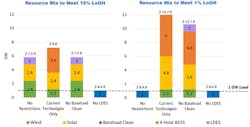Toward a 24/7 Carbon-Free Energy Future: Navigating Challenges and Opportunities
As the global transition towards a sustainable energy future gains momentum, the focus on securing carbon-free energy sources around the clock is intensifying. Industrial players, such as data centers and hydrogen producers, are leading this shift, propelled by legislative mandates and advancements in technology. Electric utilities are also integrating this goal into their resource planning processes.
Introducing the Loss of Green Hours (LoGH) Metric
To help stakeholders balance decarbonization goals with the need for a reliable and economically viable energy mix, we propose a new metric: Loss of Green Hours (LoGH). LoGH measures the portion of hours that must be met by carbon-emitting resources, offering a clear benchmark for evaluating progress toward 24/7 CFE. Our analysis shows that lower LoGH targets necessitate a resource mix with higher installed capacity and may require the integration of emerging carbon-free technologies.
Modeling for a Carbon-Free Grid: Challenges and Solutions
Identifying the least-cost resource mix for systems with high renewable capacities and flat load shapes presents significant challenges. Traditional approaches, such as planning reserve margins and effective load carrying capabilities, are less effective in these scenarios. Moreover, our research highlights that portfolios based on a single weather year can vary widely, depending on the chosen year (see Figure 1). To address these issues, we adopted an optimization model that considers multiple weather years, incorporating uncertainty into the decision-making process. This approach enables the identification of resource mixes capable of meeting decarbonization targets under varying weather conditions.Case Study: Pathways to 24/7 CFE for Data Centers in the American Southwest
To demonstrate our modeling approach, we conducted a case study for a notional data center developer in the American Southwest. Using our multi-weather year optimization model, we identified the least-cost resource mix under a variety of LoGH targets (15%, 5%, and 1%) and with various technology options including wind, solar, lithium-ion storage, long-duration energy storage, and baseload clean CFE.
Our findings reveal that developers with modest LoGH targets can achieve their decarbonization goals using existing technologies. However, these resource mixes may require some gas or other peaking technologies to protect against extreme events and renewable lulls, leading to potential renewable curtailment of around 21%. We also found that the synergistic use of technologies with complementary seasonal patterns can enhance the efficiency of existing renewable resources. Long-duration energy storage in particular proved effective in reducing the required installed capacity of generating resources by approximately 20% and reduce renewable curtailment (see Figure 2).
For developers pursuing aggressive LoGH targets, our study indicates that a substantial overbuild of resources would be necessary to meet these ambitious goals (see Figure 3). For example, achieving near-zero LoGH targets with existing wind, solar, and lithium-ion storage technologies would require installed capacities up to 12 times the data center load. In such cases, next-generation carbon-free technologies, like small modular reactors and advanced geothermal, become critical. However, our study found no significant synergies between baseload CFE technologies and legacy renewable technologies for flat load shapes. The pathway to 24/7 CFE for variable load shapes is likely to benefit from a combination of emerging and existing technologies.
Strategies for a Carbon-Free Future
Achieving a 24/7 carbon-free energy future demands a multifaceted approach. In the short term, fully realizing 24/7 clean energy may be challenging due to the substantial overbuilding required to meet aggressive LoGH targets with current technologies. To mitigate risks, developers should consider multiple weather years in their planning, seek resource mixes with complementary weather patterns, capitalize on existing and future transmission infrastructure for greater solar diversity, and design incentives to shift demand to periods of peak renewable generation. Additionally, unlocking the full potential of renewable assets will likely necessitate significant investment in the transmission system.
Emerging carbon-free baseload technologies are expected to play a pivotal role in the next decade, particularly for high-capacity-factor loads. Market and technological innovations, including developments in power purchase agreements that incorporate storage offtake and green premium pricing will also be essential in bridging the gap between intermittent renewable energy sources and consistent power demand. As these solutions converge, they promise not only to revolutionize power grids, but also to pave the way for a cleaner, more resilient energy future.
Conclusion
The journey toward 24/7 carbon-free energy is fraught with challenges but ripe with opportunities. By leveraging new metrics like LoGH, adopting robust modeling approaches, and embracing emerging technologies, stakeholders can navigate the complexities of this transition. The ongoing evolution of energy markets and technologies will be key to achieving a truly sustainable, carbon-free energy future.
About the Author
Oliver Stover
Oliver Stover, Senior Associate at Charles River Associates
Anya Lomsadze
Anya Lomsadze - Energy Analyst at Charles River Associates



